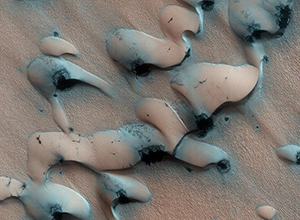Washington, Jan 4: Scientists using data from a NASA probe have unveiled 3D subsurface images of Mars polar ice caps, showing previously obscured layering, larger volume of frozen carbon dioxide and bowl-shaped features that may be buried impact craters.
The information will help scientists better understand Martian climate changes and may allow them to determine the age of the polar caps without using climate models.
The 3D data volumes were assembled from observations by the Shallow Radar (SHARAD) onboard NASA's Mars Reconnaissance Orbiter (MRO) during more than 2000 orbit passes over each Martian pole.
"We have applied industry-developed techniques in a very novel fashion to a martian dataset, producing 3D volumes that are each over 600 times larger than any terrestrial or planetary dataset of this kind," said Nathaniel E Putzig, a senior scientist at the Planetary Science Institute in the US.
"It is gratifying to see so plainly in the SHARAD volumes structures that took years of effort to characterise with the single-orbit profiles," Putzig said.
Layering seen at the surface of the martian polar caps has been studied for decades. It has long been thought to represent a record of climate changes on that planet.
The interior structures of the caps remained a mystery until the arrival of radar sounders at Mars in the last decade.
An early version of the north polar 3D volume helped to assess the quantity of water ice transferred to the polar caps in the most recent retreat from a martian ice age.
First looks at the south polar 3D volume indicate that previously mapped deposits of carbon dioxide ice are somewhat larger than reported.
In both polar 3D volumes, known impact craters in and near the polar caps that are partially filled with ice have distinctive bowl-shaped signatures in the radar data, and similar signatures are found elsewhere within the polar ices but without any surface expression.
Whether the latter structures truly are impact craters remains to be determined.
Age estimates of planetary surfaces throughout the solar system rely on statistical data for impact craters on the Moon's surface calibrated to radiometrically dated samples returned during the Apollo programme.
This method has been used to estimate the surface ages of the martian polar caps, but estimates for the ages of the caps themselves have had to rely on numerical models of past climate changes.
If a sufficient number of the bowl-shaped features found in the radar volumes are shown to be impact craters, scientists will be able to assess the age of the polar caps using cratering statistics alone.
The extent to which age estimates from this new volumetric method agree or disagree with those from climate models will have important implications for the accuracy of these dating techniques.





Comments
Add new comment